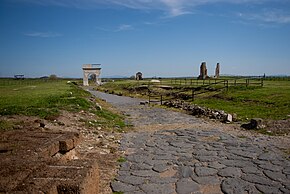Vulci

The archaeological site of Vulci
|
|
| Alternate name | Volci, Velch, Velx |
|---|---|
| Location | Montalto di Castro, Province of Viterbo, Lazio, Italy |
| Region | Latium |
| Coordinates | 42°25′08″N 11°37′54″E / 42.41889°N 11.63167°ECoordinates: 42°25′08″N 11°37′54″E / 42.41889°N 11.63167°E |
| Type | Settlement |
| Site notes | |
| Ownership | Public |
| Management | Soprintendenza per i Beni Archeologici dell'Etruria Meridionale |
| Public access | Yes |
| Website | Vulci Archaeological Naturalistic Park |
Vulci or Volci was a rich and important Etruscan city (in Etruscan, Velch or Velx, depending on the romanization used).
As George Dennis wrote: "Vulci is a city whose very name.... was scarcely remembered, but which now, for the enormous treasures of antiquity it has yielded, is exalted above every other city of the ancient world.."
Many impressive remains of the city can be seen today.
Vulci was located near the coast of the Tyrrhenian Sea about 80 km northwest of Rome, on the Fiora River, between Montalto di Castro and Canino.
The Vulci, like other Etruscans, became master sculptors in bronze as acknowledged by ancient writers. Although most large bronzes have been lost, there remain some magnificent examples of Etruscan bronze work such as the Chimera of Arezzo and the Monteleone chariot, possibly made in Vulci.
In the 19th century thousands of the ancient tombs of Vulci were discovered, and many were so well-known and spectacular, such as the Tomb of the Sun and Moon, that they were included on the Grand Tour of Europe. From these tombs more Attic vases have been found in the Vulci tombs than at any other ancient site (at least by the 1850s) and many of these masterpieces as well as Etruscan bronzes have found their way into the major museums of the world where they can be seen today.
Despite these discoveries most of these tombs were later forgotten and lost.
The Vulci were a tribe or people who gave their name to their city and were one of the legendary twelve peoples of Etruscan civilization who later formed the dodecapolis Etruscan League to protect their interests.
Although the wealth, magnificence and population of Vulci must have been among the first of Etruscan cities, it is mentioned only rarely in ancient literature or potential texts for some periods have been lost; hence the history of Vulci may be reconstructed mainly from archaeology.
In the Villanovan period, the wealth of metal resources in the Colline Metallifere hills was important in the development of trade especially with Sardinia. The most important discovery that testifies to the contact between Etruscans and Sardinians in this period was the Tomb of the Sardinian Bronzes in 1958 in the necropolis of Cavalupo, dated 850-800 BC, of a Sardinian woman of high rank. Among the funeral contents is a magnificent bronze statue of a warrior now in the National Etruscan Museum museum in the Villa Giulia. Numerous Villanovan fibulas have also been found in Sardinia.
...
Wikipedia

